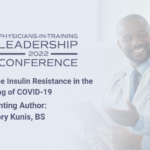Abstract | April 4, 2022
A Case of Extreme Insulin Resistance in the Setting of COVID-19
Introduction: Obesity and insulin resistance have been shown to be lethal comorbid conditions in COVID-19 patients. One major association being studied is insulin resistance and ACE-2 expression. ACE-2 expression is decreased during a COVID-19 infection which leads to an increase in angiotensin-II which precipitates insulin resistance (IR). IR is the main factor that pre-empts the activation of an inflammatory response and further cytokine storms. These effects combine to cause dysregulation in the alveolar epithelium leading to acute respiratory distress symptoms. Extreme IR has been documented in severely ill COVID19 patients, however the mechanism is not yet well defined.
Case Presentation: We present a 40-year-old woman with severe COVID-19 pneumonia, sepsis, and acute kidney failure requiring intubation and dialysis. On day five of admission, this patient had increasing hyperglycemia resistant to a high-dose sliding scale insulin. She was escalated to an insulin drip but the hyperglycemia persisted. The drip was titrated up to as high as 99 units of insulin/hour for over 24 hours, still with minimal changes in glucose levels. The rate was adjusted for three days until her glucose eventually stabilized and she could be weaned off the drip.
Final/Working Diagnosis: While attempting to identify the cause of this severe IR, multiple considerations were made. The patient tested negative for insulin antibodies and her central line was intact and patent. There is scant literature demonstrating the ability of levophed to inactivate insulin if given through the same line. The patient was receiving levophed through the same line as the insulin (in a different lumen), however this doesn’t explain the eventual stabilization of her glucose levels. Therefore, the final consideration was that the COVID-19 cytokine storm caused an extreme level of insulin resistance never before documented.
Management/Outcome/Follow-up: There was still much difficulty in stabilizing the patient’s blood glucose levels, but not nearly as much during that three-day period and she was able to stay off the insulin drip moving forward. Unfortunately, the severe complications of her illness took too much of a toll on her body and she succumbed to the illness after over a month in the ICU.
References and Resources:
- Bansal R, Gubbi S, Muniyappa R. Metabolic Syndrome and COVID 19: Endocrine-Immune-Vascular Interactions Shapes Clinical Course. Endocrinology. 2020 Oct 1;161(10):bqaa112. doi: 10.1210/endocr/bqaa112.
- Frisardi V. Commentary: Coronavirus and Obesity: Could Insulin Resistance Mediate the Severity of Covid-19 Infection?. Front Public Health. 2020;8:351. Published 2020 Jul 7. doi:10.3389/fpubh.2020.00351
- Govender N, Khaliq OP, Moodley J, Naicker T. Insulin resistance in COVID-19 and diabetes. Prim Care Diabetes. 2021;15(4):629-634. doi:10.1016/j.pcd.2021.04.004
- Khoury N, McGill JB. Reduction in insulin sensitivity following administration of the clinically used lowdose pressor, norepinephrine. Diabetes Metab Res Rev. 2011;27(6):604-608. doi:10.1002/dmrr.1212
- Straub SG, Sharp GW. Evolving insights regarding mechanisms for the inhibition of insulin release by norepinephrine and heterotrimeric G proteins. Am J Physiol Cell Physiol. 2012 Jun 15;302(12):C1687-98. doi: 10.1152/ajpcell.00282.2011.
- Underwood PC, Adler GK. The renin angiotensin aldosterone system and insulin resistance in humans. Curr Hypertens Rep. 2013 Feb;15(1):59-70. doi: 10.1007/s11906-012-0323-2.

